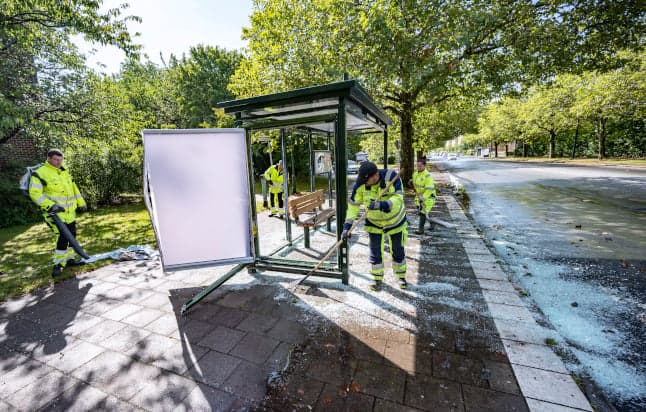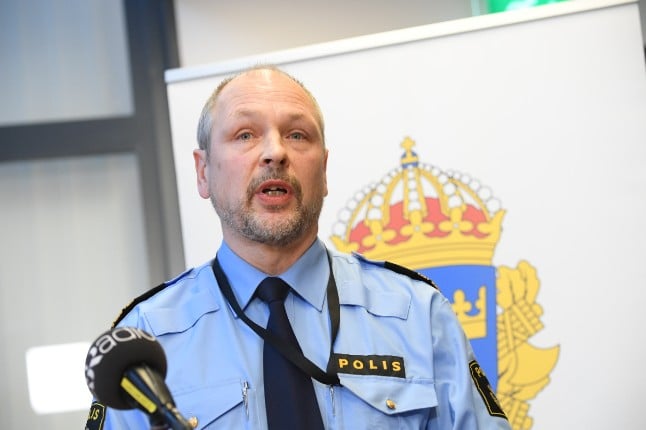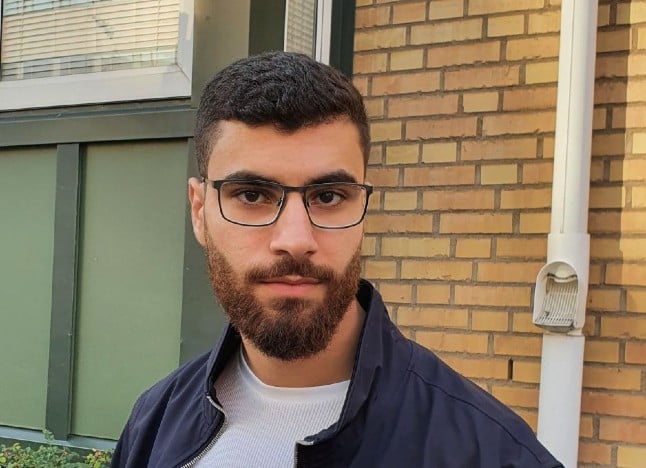How Malmö's Rosengård district bounced back after Koran burning sparked riots

When the last rioters finally went home, Younes al-Dahdouli's neighbour rounded up two friends and went out to clear up.
"There were a lot of stones and signs and other things which they had blockaded the road with," al-Dahdouli told The Local. "There was a friend who said, 'why don't we tidy up? It's our area after all. It's where we live'."
The riot in the Malmö district of Rosengård on August 28th, in response to far-right Danish activists burning a copy of the Koran nearby and kicking it around in one of the southern Swedish city's main squares, had been the worst since the area erupted into violence back in 2008.
A group of young men had set alight tyres and pummelled the police vans blockading the street with chunks of paving stone in a confrontation which lasted from early evening until way past midnight.
READ ALSO:
It was 2am in the morning when the clear-up began, and before long the initial three had grown to a small group of 15 or more, with al-Dahdouli among them.
Most stayed up all night to clear the road of debris. When workers from the municipal roads authority came to reopen the street that morning, more locals came to help out.
The video below shows people clearing up some of the debris:
Step change in citizen involvement
According to Erik Jansåker, who leads the police in southern Malmö, this voluntary clear-up is unprecedented in Rosengård.
"What has been a little bit unique is how the locals got together to clear up the mess afterwards, which we haven't seen before," he said.
He said locals also worked to prevent a second outbreak of violence the next Saturday, ejecting a group of people who came from outside the district trying to escalate a peaceful demonstration into another riot.
"It was people living in Rosengård who held the manifestation, but then some people came from outside who wanted to burn and destroy things," al-Dahdouli said. "And we threw them out from there, and then we spoke to the police and they came and helped."
A few days later, a group came and made another attempt to instigate violence, and were again told by the locals to leave.
"The locals made sure that they went away, and that's also new for us out here and it shows that the area has gone in the right direction," Jansåker said. "There has been self-policing in a totally different way from what we've seen before."
He isn't sure what has changed. Perhaps the fact that this time the riot had been held in the name of religion motivated the silent majority.
"Most of the people that live there are good citizens, and it's a little group that are a problem. But previously they haven't wanted to get involved. This time they dared to come forward."
Police also made sure that the municipal roads and parks authority repaired the damage as quickly as possible to stop Rosengård looking like a lawless area, something studies show encourages more crime.

Erik Jansåker, the district police chief for southern Malmö. Photo: Johan Nilsson/TT
Investigating the wrongdoers
Malmö police have been working hard to rebuild trust in the community, but they have also been pursuing those involved in the rioting, with a 14-strong investigation team combing through camera footage of the night.
"Thirteen were seized on the night, one is still being held, and we are doing more and more picture analysis of those who threw stones and damaged police vehicles, we are identifying a couple more every day," Jansåker said.
A 58-year-old woman has been arrested on suspicion of being one of the instigators of the riot, and, according to the Sydsvenskan newspaper, a 16-year-old girl is also suspected of being involved.
According to the newspaper, police have so far laid down a total of 30 different allegations of crimes such as sabotaging a police or emergency vehicle, vandalism and violence against a government official.
According to the Aftonbladet newspaper, six people are also suspected of hate crimes connected to the illicit far-right rally in Stortorget.
While Sydsvenskan reports that 300 people were involved in the rioting, al-Dahdouli said that the real number was much smaller, with the majority of those involved in the initial demonstration in Rosengård going home when it got violent.
"The more it became a violent riot, the less people stayed. It was more like 50 people who were violent."

Allan Hadrous, a board member of Skandinavia WAKF, which runs a new mosque near Rosengård. Photo: Private
Working with imams
Jansåker said that police had worked hard in the days after the riot to explain their actions to the locals, particularly to practising Muslims who felt their religion had been attacked.
"Many of those who were at the place thought that the police had said 'ok' to the Danish man, and many thought that police had given permission for that demonstration, so a big part of it was clearing up that misunderstanding," he said.
But Allan Hadrous, a board member of one mosque near to where the rioting took place, told The Local that many among his congregation remained upset that Malmö police had not done more to prevent a group of activists from Denmark's Hard Line anti-immigration party kicking around a copy of the Koran in Malmö's main city square.
"They were most upset at what happened at Stortorget. There was a great disappointment that the police didn't stop a forbidden demonstration, and many felt that the police had deceived us and deceived our imam."
But he stressed that, so far as he knew, his congregation members were against the violence.
"I've heard no information that a single one of our members was involved and it's really regrettable that stones were thrown at the police. The violence was an absolute overreaction. We are absolutely against what happened."
Hadrous said that police had claimed they lacked the legal powers to arrest the far-right activists preemptively.
But he said he believed politicians, both in Malmö and in Stockholm, should have done and said more in the aftermath.
"It's the national politicians who have more power to change the rules, and I've seen nothing from the politicians in parliament calling to do something which could stop this happening in the future," he said.
"They should really look again at how they can change the hate laws that protect various groups, because this was a definite attack on Muslims."

Younes al-Dahdouli at home in Rosengård. Photo: Private
Good atmosphere one week on
Jansåker said that he believed the community police in Rosengård had helped reduce tension after the disruptions.
"One of the success factors is that we have old, experienced officers who work in the area, and who have worked there for many years, who know how the game works," he said. "It's easier to throw a stone at someone you don't know, and if you have a good relation to the troublemakers, it is easier to talk to them."
And two weeks on, al-Dahdouli said he didn't feel that Rosengård has become any more tense as a result of the riot.
"It feels very calm actually, especially after Saturday, when people in Rosengård made clear that we didn't want to have violence," he said.
The lesson, he argued, was that citizens in the area had to stand up and take action.
"You should go out on the street and help. You shouldn't sit at home on a screen and just write negative things," he said. "The media always shows those who cause trouble, not the good picture. Now we've had a chance to be seen."
Comments
See Also
"There were a lot of stones and signs and other things which they had blockaded the road with," al-Dahdouli told The Local. "There was a friend who said, 'why don't we tidy up? It's our area after all. It's where we live'."
The riot in the Malmö district of Rosengård on August 28th, in response to far-right Danish activists burning a copy of the Koran nearby and kicking it around in one of the southern Swedish city's main squares, had been the worst since the area erupted into violence back in 2008.
A group of young men had set alight tyres and pummelled the police vans blockading the street with chunks of paving stone in a confrontation which lasted from early evening until way past midnight.
READ ALSO:
It was 2am in the morning when the clear-up began, and before long the initial three had grown to a small group of 15 or more, with al-Dahdouli among them.
Most stayed up all night to clear the road of debris. When workers from the municipal roads authority came to reopen the street that morning, more locals came to help out.
The video below shows people clearing up some of the debris:
Step change in citizen involvement
According to Erik Jansåker, who leads the police in southern Malmö, this voluntary clear-up is unprecedented in Rosengård.
"What has been a little bit unique is how the locals got together to clear up the mess afterwards, which we haven't seen before," he said.
He said locals also worked to prevent a second outbreak of violence the next Saturday, ejecting a group of people who came from outside the district trying to escalate a peaceful demonstration into another riot.
"It was people living in Rosengård who held the manifestation, but then some people came from outside who wanted to burn and destroy things," al-Dahdouli said. "And we threw them out from there, and then we spoke to the police and they came and helped."
A few days later, a group came and made another attempt to instigate violence, and were again told by the locals to leave.
"The locals made sure that they went away, and that's also new for us out here and it shows that the area has gone in the right direction," Jansåker said. "There has been self-policing in a totally different way from what we've seen before."
He isn't sure what has changed. Perhaps the fact that this time the riot had been held in the name of religion motivated the silent majority.
"Most of the people that live there are good citizens, and it's a little group that are a problem. But previously they haven't wanted to get involved. This time they dared to come forward."
Police also made sure that the municipal roads and parks authority repaired the damage as quickly as possible to stop Rosengård looking like a lawless area, something studies show encourages more crime.

Erik Jansåker, the district police chief for southern Malmö. Photo: Johan Nilsson/TT
Investigating the wrongdoers
Malmö police have been working hard to rebuild trust in the community, but they have also been pursuing those involved in the rioting, with a 14-strong investigation team combing through camera footage of the night.
"Thirteen were seized on the night, one is still being held, and we are doing more and more picture analysis of those who threw stones and damaged police vehicles, we are identifying a couple more every day," Jansåker said.
A 58-year-old woman has been arrested on suspicion of being one of the instigators of the riot, and, according to the Sydsvenskan newspaper, a 16-year-old girl is also suspected of being involved.
According to the newspaper, police have so far laid down a total of 30 different allegations of crimes such as sabotaging a police or emergency vehicle, vandalism and violence against a government official.
According to the Aftonbladet newspaper, six people are also suspected of hate crimes connected to the illicit far-right rally in Stortorget.
While Sydsvenskan reports that 300 people were involved in the rioting, al-Dahdouli said that the real number was much smaller, with the majority of those involved in the initial demonstration in Rosengård going home when it got violent.
"The more it became a violent riot, the less people stayed. It was more like 50 people who were violent."

Allan Hadrous, a board member of Skandinavia WAKF, which runs a new mosque near Rosengård. Photo: Private
Working with imams
Jansåker said that police had worked hard in the days after the riot to explain their actions to the locals, particularly to practising Muslims who felt their religion had been attacked.
"Many of those who were at the place thought that the police had said 'ok' to the Danish man, and many thought that police had given permission for that demonstration, so a big part of it was clearing up that misunderstanding," he said.
But Allan Hadrous, a board member of one mosque near to where the rioting took place, told The Local that many among his congregation remained upset that Malmö police had not done more to prevent a group of activists from Denmark's Hard Line anti-immigration party kicking around a copy of the Koran in Malmö's main city square.
"They were most upset at what happened at Stortorget. There was a great disappointment that the police didn't stop a forbidden demonstration, and many felt that the police had deceived us and deceived our imam."
But he stressed that, so far as he knew, his congregation members were against the violence.
"I've heard no information that a single one of our members was involved and it's really regrettable that stones were thrown at the police. The violence was an absolute overreaction. We are absolutely against what happened."
Hadrous said that police had claimed they lacked the legal powers to arrest the far-right activists preemptively.
But he said he believed politicians, both in Malmö and in Stockholm, should have done and said more in the aftermath.
"It's the national politicians who have more power to change the rules, and I've seen nothing from the politicians in parliament calling to do something which could stop this happening in the future," he said.
"They should really look again at how they can change the hate laws that protect various groups, because this was a definite attack on Muslims."

Younes al-Dahdouli at home in Rosengård. Photo: Private
Good atmosphere one week on
Jansåker said that he believed the community police in Rosengård had helped reduce tension after the disruptions.
"One of the success factors is that we have old, experienced officers who work in the area, and who have worked there for many years, who know how the game works," he said. "It's easier to throw a stone at someone you don't know, and if you have a good relation to the troublemakers, it is easier to talk to them."
And two weeks on, al-Dahdouli said he didn't feel that Rosengård has become any more tense as a result of the riot.
"It feels very calm actually, especially after Saturday, when people in Rosengård made clear that we didn't want to have violence," he said.
The lesson, he argued, was that citizens in the area had to stand up and take action.
"You should go out on the street and help. You shouldn't sit at home on a screen and just write negative things," he said. "The media always shows those who cause trouble, not the good picture. Now we've had a chance to be seen."
Join the conversation in our comments section below. Share your own views and experience and if you have a question or suggestion for our journalists then email us at [email protected].
Please keep comments civil, constructive and on topic – and make sure to read our terms of use before getting involved.
Please log in here to leave a comment.